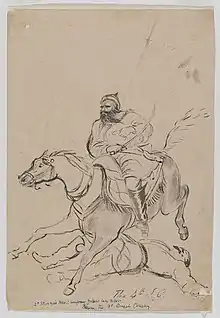Barabasti
Barabasti or BarahBasti initially had a group of 12 villages but later it exceeds and now they are more than 12 lying in Bulandshahr district in the Indian state of Uttar Pradesh. These villages are located adjacent to each other within an area of seven square miles, and noted for a high population of Pathans, in addition to other Muslims and Hindus.[2]
Barahbasti | |
|---|---|
village | |
| Country | |
| State | Uttar Pradesh |
| District | Bulandshahr |
| Languages | |
| • Official | Hindi[1] |
| • Additional official | Urdu[1] |
| Time zone | UTC+5:30 (IST) |
| Nearest city | Bulandshahr |
Villages
The name "Barabasti" is derived from the term "Barah Basti", 12 villages and town of Pathans which in Hindustani means "twelve settlements". The twelve villages, now under the districts of Bulandshahr, Ghaziabad and Amroha, are Basi, Giroura, Bugrasi, Jalalpur, Chandiyana, Gesupur, Barwala, Amarpur, Sherpur, Bahadurgarh, Hasanpur, Mohammadpur, Khanpur, Daulatpur Kalan.[3][4] The naming of the "twelve villages" in Hindustani was similar to the naming of the Sadaat-e-Bara of Muzaffarnagar.[5]
History
The Pathans of Barah basti played an important role in the Indian Rebellion of 1857. Abdul Latif Khan of Khanpur who was head of the Barah Basti Pathans raised the standard of revolt against the British.[6] writing a petition to Bahadur Shah Zafar promising to come to the Dehli court, and to bring some elephants with him, representing that he had been unwell.[7] He was captured in Jahangirabad and convicted by a military commission of aiding the rebels in every way in his power and was sentenced to transportation for life.[8][9] Walidad Khan of Malagarh, Bulandshahr occupied Aligarh and Khurja and attracted to his standard the fanatic Muslims of the Barah Basti in Bulandshahr district in the regions of Ahar and Sayana, from which many of the sowars of the Irregular Cavalry were recruited.[10] Walidad Khan was joined by his 'near relation' Ismail Khan, who was the kotwal of Meerut and had served in the Skinner's Horse.[11]

Transport
Barahbasti is about 100 km from Delhi. Barabasti can be reached by road in a three-hour drive from Delhi. Time can be saved by taking the expressway from Delhi to Noida, then the Dankaur station road to Bulandshahr. Then from Bulandshahr to Siyana which is just 8 km from Barabasti.
Economy
The economy of this area is based on agriculture. Barahbasti has many mango orchards, many varieties of mangoes are grown here like Dusseri, Bombayi, Chausa, Langda, Gulab-Jamun, Ratol and Fajri. You can find More than 100s varieties of mangoes in Barahbasti which are limited for their personal taste. The area supplies a large number of mangoes to the country, and has been declared fruit belt by the government of Uttar Pradesh. Hundreds of trucks loaded with mangoes go to various places including Azadpur Mandi (fruit market) in Delhi, and some of best mangoes are exported to Gulf and European markets.
Demographics
Barabasti has a mix of Muslims and Hindus.[2] However, it is noted for its relatively large Pathan population.
Notable people
- Arif Mohammad Khan,[12] from Barwala. Governor of Kerala, former Civil Aviation Minister in the Indian Central Government, a two-time Member of Parliament (MP) and a three-time MLA. Governor of Kerala.
References
- "Report of the Commissioner for linguistic minorities: 52nd report (July 2014 to June 2015)" (PDF). Commissioner for Linguistic Minorities, Ministry of Minority Affairs, Government of India. pp. 49–53. Archived from the original (PDF) on 15 November 2016. Retrieved 16 February 2016.
- All India Reporter. Nagpur: D.V. Chitaley. 1. 1940. ISSN 0002-5593. OCLC 183901674.
{{cite journal}}: Missing or empty|title=(help) - "Barahbasti - Family Book and History of Pathans of Barabasti Uttar Pradesh India - Yadgar e Salf". 29 June 2022.
- "Barahbasti Pathans, Bulandshahar, Hapur and Amroha". www.studiodharma.in. 6 March 2022. Retrieved 29 June 2022.
- Proceedings:Volume 55. Indian History Congress. 1995. p. 435.
- Kripal Chandra Yadav (1980). Delhi in 1857: Volume 1. Academic Press. p. 294.
- Yadav (1980). Delhi in 1857: The trail of Bahadur Shah. p. 294.
- Syed Athar Abbas Rizvi (1957). Freedom Struggle in Uttar Pradesh: Source Material. [Edited by S.A.A. Rizvi and M.L. Bhargava.]. Publications Bureau Information Department Uttar Pradesh.
- The Revolt of 1857. K. K. Publications. p. 170.
- Fleetwood Williams. Narrative of Events Attending the Outbreak of Disturbances and the Restoration of Authority in the District of Meerut in 1857-58. Government Press. p. 59.
- Bengal, Past & Present:Journal of the Calcutta Historical Society · Volume 86. Calcutta Historical Society. 1967. p. 47.
- L.H. Naqvi (28 March 2004). "Betrayed by Arif Khan, Barabasti Pathans root for RLD man". The Tribune. Retrieved 28 August 2010.